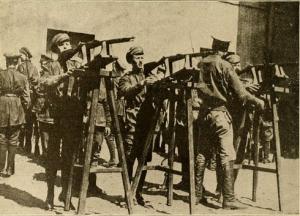Chemical weaponsHHS sponsors inhaled chlorine antidote for chemical terrorism preparedness
Chlorine gas is a widely available industrial chemical with catastrophic consequences in industrial accidents. chlorine gas has been used as a weapon, for the first time in the First World War and repeatedly in the recent Syrian civil war. Currently, there is no specific antidote for lung injuries caused by chlorine exposure, and treatment has been limited supportive care. The first potential antidote to treat the life-threatening effects of chlorine inhalation, a potential terrorism threat, will advance in development under a contract between the U.S. Department of Health and Human Services’ (HHS) Office of the Assistant Secretary for Preparedness and Response (ASPR) and Radikal Therapeutics, Inc. of Beverly, Massachusetts.

Chlorine gas as a weapon began with the German Army of World War I // Source: commons.wikimedia.org
The first potential antidote to treat the life-threatening effects of chlorine inhalation, a potential terrorism threat, will advance in development under a contract between the U.S. Department of Health and Human Services’ (HHS) Office of the Assistant Secretary for Preparedness and Response (ASPR) and Radikal Therapeutics, Inc. of Beverly, Massachusetts.
Currently, there is no specific antidote for lung injuries caused by chlorine exposure, and treatment has been limited supportive care.
Chlorine gas is a widely available industrial chemical with catastrophic consequences in industrial accidents. Derailment of a train carrying chlorine in Graniteville, South Carolina, in 2005 led to nine deaths and hundreds of injuries. In addition, chlorine gas has been used as a weapon, for the first time in the First World War and repeatedly in the recent Syrian civil war.
HHS says that a two-year $15.9 million contract, announced Thursday, is part of efforts by ASPR’s Biomedical Advanced Research and Development Authority (BARDA) to develop medical products and procedures to protect health and save lives in a terrorist attack, including those using toxic industrial chemicals like chlorine. The contract could be extended up to a total of $84.9 million over seven years.
“The United States faces a wide variety of threats to health security — from new infectious diseases like Zika to bioterrorism and accidents involving deadly gases like chlorine,” said BARDA Acting Director Dr. Richard Hatchett. “Not being prepared for any of them could cost lives; we must be ready to protect health against the multitude of threats our country faces.”
Radikal’s development of the antidote known as R-107 began with more than $2.6 million in funding over four years from the National Institutes of Health CounterACT program. Under Thursday’s agreement with ASPR, the company will develop a more efficient way to produce large quantities of R-107 and conduct non-clinical studies to establish the drug’s safety and effectiveness as a lifesaving treatment for acute lung injury resulting from inhaled chlorine.
If non-clinical studies are successful, R-107 could begin clinical studies to establish safety and efficacy in humans. This development work would not expose people to dangerous levels of chlorine gas and would support Radikal’s submission of an application to the U.S. Food and Drug Administration (FDA) for approval of R-107 as an antidote for chlorine exposure.
ASPR notes that BARDA continues to seek proposals for the development of effective medical countermeasures and interventions for chemical threats, including new products and new indications for products already in clinical use. The products must be easy to use in a mass casualty situation and safe and effective for all segments of the population. Proposals are accepted through the Broad Agency Announcement BARDA-CBRN- BAA-16-100-SOL-00001 at the Federal Business Opportunities Web site, www.fbo.gov.
HHS says that this new project is part of an integrated portfolio approach to the advanced research and development, innovation, acquisition, and manufacturing of medical countermeasures — vaccines, drugs, therapeutics, diagnostic tools, and non-pharmaceutical products for public health emergency threats. These threats include chemical, biological, radiological, and nuclear (CBRN) agents, pandemic influenza, and emerging infectious diseases.
ASPR partners with other federal agencies, in particular the National Institutes of Health, as well as private industry to develop medical products needed to mitigate the health effects of disasters and other public health emergencies. Potential products may transition from basic research and early clinical trials at NIH divisions to BARDA for support of the advanced development necessary to earn FDA approval or licensure.
ASPR describes itself as HHS’s lead agency for preparing the United States to respond to and recover from adverse health effects of emergencies, supporting communities’ ability to withstand adversity, strengthening health and response systems, and enhancing national health security.
